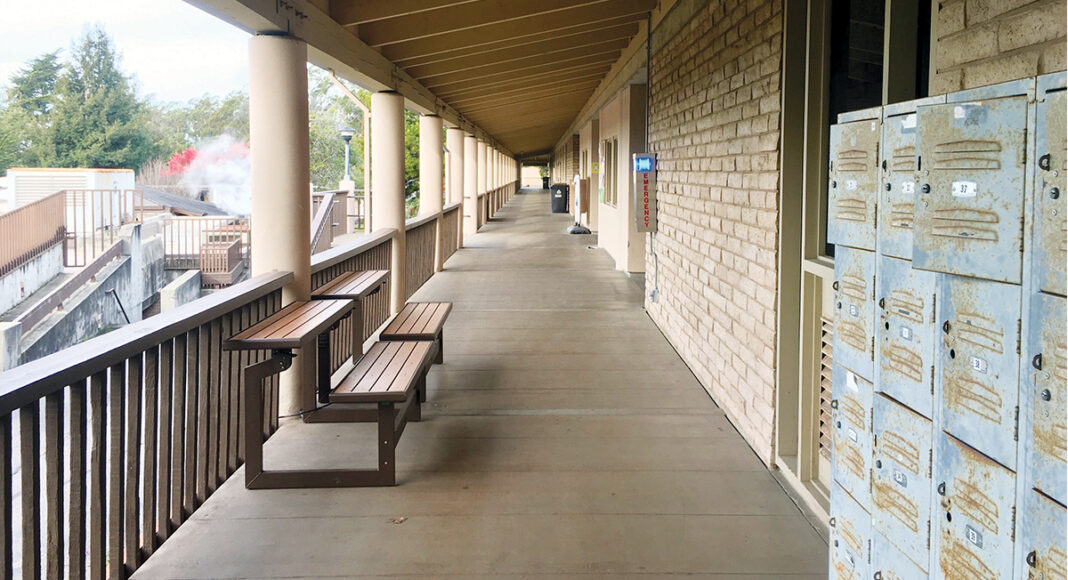Cabrillo College Trustee Adam Spickler knows that everyone has seen the good-looking buildings that line Soquel Drive, as part of the school’s arts campus.
But go uphill aways, Spickler says, and you’ll see lots of older facilities, buildings constructed as many as 60 years ago.
“That’s the last time any of those buildings have been touched, and they’re in bad need of repair,” Spickler says. “They were built for class sizes that were imagined in 1960. Well, that’s changed here in 2020.” Small classrooms make for small class sizes. Classes end up being tough to get into, and the end result, Spickler says, is that it takes students longer to graduate.
With the election approaching March 3, Spickler is campaigning for Measure R, a $274 million facilities initiative for the community college, targeted at repairs, classroom upgrades, science labs, new wiring, and sewer line improvements. The bond would be paid via property tax bills, and it needs 55% voter approval in order to pass. A previous effort from the community college’s supporters—a $310 million measure—failed in 2016, coming within one-and-a-half percentage points of passing. Although Spickler wasn’t on the board at the time, he says everyone learned from the previous campaign. The new measure has slimmed down a little bit, with increased focus on students. Supporters have additionally gotten better at communicating the school’s needs, he says.
Measure R opponents, like Aptos resident Kris Kirby, say Santa Cruz is taxed out.
Kirby, who also opposed the Measure H affordable housing bond in 2018, dislikes property tax measures, in general. This tax, she says, will get passed along to renters, and she thinks Cabrillo should get revenue some other way. “Rents go up. Property bills go up. I think they should get private donations instead. It worries me, the seniors and single parents that are struggling. If they’re struggling, this is going to make it that much worse. I don’t think it’s fair,” Kirby says.
Kirby says she worries about the impact the measure would have on seniors, who aren’t exempted from the measure. She and adds that if Cabrillo were focusing more on maintenance, it wouldn’t need so much money for building repairs.
Communications specialist Bill Maxfield, who’s been providing public relations support to the Measure R campaign, says state law doesn’t allow for a senior exemption on this measure. And Spickler notes that the state only provides $240,000 a year for maintenance. The college burned through almost half of that last year, all at once, when a sewer pipe burst on campus.
Opponents point out that taxpayers are still paying off two older bond measures. But Cabrillo did recently refinance old bond debt, saving taxpayers $29.5 million.
“We’re doing so much responsibly and thoughtfully as we can,” Spickler says.
MEASURES WITH NO OPPOSITION:
SAN LORENZO VALLEY
The San Lorenzo Valley has one initiative—a bond measure that also needs 55% voter approval. The $75 million Measure S would generate funds to repair and replace schools’ leaky roofs, make energy-efficient upgrades, build new science and career education facilities, and handle renovations. It would levy taxes of approximately 6 cents per $100 of assessed value.
SANTA CRUZ
Santa Cruz has four local measures on the ballot. Measure T would continue funding Career Technical Education, science, technology, engineering, arts, counseling, library and athletic programs. This Santa Cruz City High School District measure renews an otherwise expiring parcel tax at the current $110-per-parcel annual rate, providing $3.7 million in annual school funding. Measure U supports continued funding in science, art music, library support, counseling services and small class sizes at Santa Cruz elementary and middle schools. At a rate of $208 per parcel, it would raise $3.2 million in annual school funding. Both of these parcel taxes need a two-thirds vote in order to pass.
Measure X would transition Santa Cruz City School elections away from at-large races and down a path for district elections. The school board has already decided this is the best course of action. Voter approval would let the school district proceed, and also avoid a lawsuit from a voting rights law firm over its old election set-up.
One last Santa Cruz measure deal has nothing to do with schools at all. Measure W would allow the city of Santa Cruz greater flexibility in contracting for public works construction projects. It would allow for a city amendment to change the way the city seeks bids. According to the argument in favor of the initiative, Measure W could allow for significant savings in time and money by lowering construction costs and speeding up the timeline for projects.
SCOTTS VALLEY
Aimed at protecting Scotts Valley’s quality of life, Measure Z would raise the sales tax .5%. Without the measure, the city of Scotts Valley could face slower police emergency response times, a failure to recruit and retain experienced police officers, and reduced preparation for wildfires and other emergencies. Measure Z simply needs a majority vote in order to pass. And if it does so, Scotts Valley will have the highest sales tax in the county—at 9.5%.
MID-COUNTY
Measure V aims to maintain quality education in Soquel Union Elementary School District. The initiative levies an annual tax of $96 per parcel for six years, raising $1,500,000 annually. The funds would go toward attracting and retaining highly qualified employees and preserving academic programs. To pass, it needs two-thirds support at the polls.
WATSONVILLE
The city of Watsonville has a sales tax measure of its own on the ballot. Measure Y would extend the city’s half-cent sales tax, with the revenue going toward public safety—police officers, firefighters, paramedics, after-school youth programs and safe places to keep teens out of trouble. It needs two-thirds voter support in order to pass.













